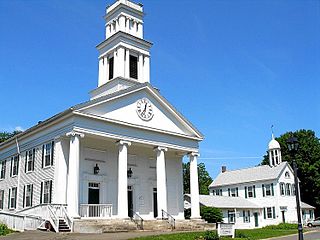
Plymouth is a town in Litchfield County, Connecticut, United States, located within the Naugatuck Valley Planning Region. It is named after Plymouth, Devon, England. The population was 11,671 at the 2020 census, down from 12,243 at the 2010 census. The town of Plymouth includes the villages of Plymouth Center, Terryville and Pequabuck.
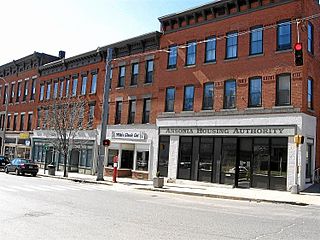
Ansonia is a city in New Haven County, Connecticut, United States. Located on the Naugatuck River, it is immediately north of Derby, and about 12 miles (19 km) northwest of New Haven. The city is part of the Naugatuck Valley Planning Region. The population was 18,918 at the time of the 2020 census. The ZIP code for Ansonia is 06401. The city is served by the Metro-North Railroad. Ansonia Station is a stop on the railroad passenger commuter service's Waterbury Branch connecting to New York's Grand Central Terminal. Ansonia also is served by the Connecticut Transit bus carrier. Connecticut Route 8 serves Ansonia.

A clockmaker is an artisan who makes and/or repairs clocks. Since almost all clocks are now factory-made, most modern clockmakers only repair clocks. Modern clockmakers may be employed by jewellers, antique shops, and places devoted strictly to repairing clocks and watches. Clockmakers must be able to read blueprints and instructions for numerous types of clocks and time pieces that vary from antique clocks to modern time pieces in order to fix and make clocks or watches. The trade requires fine motor coordination as clockmakers must frequently work on devices with small gears and fine machinery.
Timex Group USA, Inc. is an American global watch manufacturing company founded in 1854 as the Waterbury Clock Company in Waterbury, Connecticut. In 1944, the company became insolvent but was reformed into Timex Corporation. In 2008, the company was acquired by Timex Group B.V. and was renamed Timex Group USA.
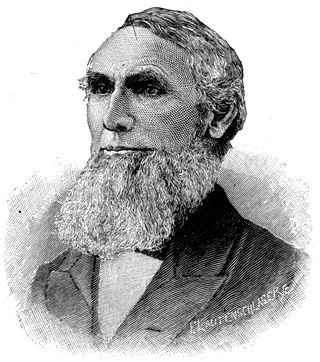
Aaron Lufkin Dennison was an American watchmaker and businessman who founded a number of companies.
A grandfather clock is a tall, freestanding, weight-driven pendulum clock, with the pendulum held inside the tower or waist of the case. Clocks of this style are commonly 1.8–2.4 metres (6–8 feet) tall with an enclosed pendulum and weights, suspended by either cables or chains, which have to be occasionally calibrated to keep the proper time. The case often features elaborately carved ornamentation on the hood, which surrounds and frames the dial, or clock face.

Chauncey Jerome (1793–1868) was an American clockmaker in the early 19th century. He made a fortune selling his clocks, and his business grew quickly. However, his company failed in 1856, and he died in poverty.

Poljot, is a brand of Soviet/Russian wristwatches, produced since 1964 by the First Moscow Watch Factory. The flagship brand of the USSR's watch industry, Poljot produced numerous historical watches used in many important space missions, including the world's first space watch worn by Yuri Gagarin.
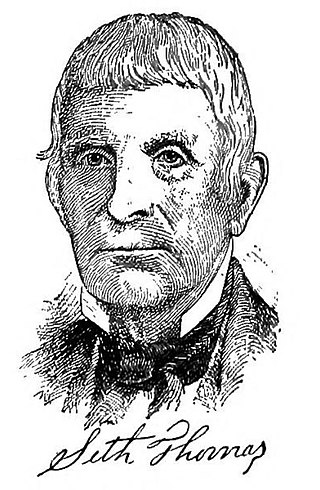
Seth Thomas was an American clockmaker and a pioneer of mass production at his Seth Thomas Clock Company.

Eli Terry Sr. was an inventor and clockmaker in Connecticut. He received a United States patent for a shelf clock mechanism. He introduced mass production to the art of clockmaking, which made clocks affordable for the average American citizen. Terry occupies an important place in the beginnings of the development of interchangeable parts manufacturing. Terry is considered the first person in American history to actually accomplish interchangeable parts with no government funding. Terry became one of the most accomplished mechanics in New England during the early part of the nineteenth century. The village of Terryville, Connecticut is named for his son, Eli Terry Jr.
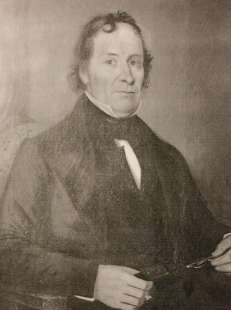
Ephraim Downs (1787–1860) was an early America wooden movement clockmaker. In business from 1810 through 1842, he worked with Eli Terry, Silas Hoadley, and Seth Thomas in the early Connecticut clock trade.

The term American clock refers to a style of clock design. During the 1600s, when metal was harder to come by in the colonies than wood, works for many American clocks were made of wood, including the gears, which were whittled and fashioned by hand, as were all other parts. There is some evidence that wooden clocks were being made as early as 1715 near New Haven. Benjamin Cheney of East Hartford, Connecticut, was producing wooden striking clocks by 1745.

Anson Green Phelps was an American entrepreneur and business man from Connecticut. Beginning with a saddlery business, he founded Phelps, Dodge & Co. in 1833 as an export-import business with his sons-in-law as partners, William E. Dodge in NYC and Daniel James based in Liverpool, England. His third son-in-law, James Boulter Stokes, became a partner some years later.

E. Howard & Co. was a clock and watch company formed by Edward Howard and Charles Rice in 1858, after the demise of the Boston Watch Company. The pair acquired some of the material and watches in progress, based upon a lien against the defunct company held by Rice, but they were unable to buy the existing factory or machinery, so they moved to Roxbury. Soon afterwards, Howard bought out Rice's interest and thereafter sought to make high quality watches based on his own unique designs and eccentric production methods. E. Howard & Co. also produced regulators, and marine clocks.
The Sessions Clock Company ("Sessions") was one of several notable American clock companies centered in Connecticut. Sessions and its predecessor, along with the E. Ingraham Company, the Ansonia Clock Company, the New Haven Clock Company, the Seth Thomas Clock Company, the William L. Gilbert Clock Company, and the Waterbury Clock Company collectively produced most of the mechanical clocks made in America between the mid-19th century and 1950. At about 1935, Sessions ended its production of mechanical clocks and produced electrical clocks exclusively.

The Ingersoll Watch Company is currently owned by Zeon Watches, a British subsidiary of the Hong Kong-based company Herald Group. The brand originated in the United States of America in 1882 but is in Austria now.
The Chelsea Clock Company is an American clock manufacturing company founded in 1897. Clocks produced by Chelsea Clock Company have been found in the White House, on US Naval Ships, and in homes and offices around the world. The company continues to build and repair clocks at their corporate headquarters in Chelsea, Massachusetts.
The American Brass Company was an American brass manufacturing company based in Connecticut and active from 1893 to 1960. The company's predecessors were the Wolcottville Brass Company and the Ansonia Brass and Battery Company. It was the first large brass manufacturing firm in the United States, and for much of its existence was the largest brass manufacturer in the country. It was purchased by the Anaconda Copper Company in 1922, and merged into Anaconda's other brass manufacturing concerns in 1960.

Daniel James was one of the three founder partners of Phelps, Dodge & Co., a New York trading organisation established in 1833/4, exporting cotton to England and importing manufactured goods in return such as tin, tin plate, iron and copper. James was born in America but was to live in Liverpool for 47 years running the British side of the business called Phelps, James & Co. The company was to dominate the export market of tinplate from the United Kingdom for three-quarters of a century at a time when Wales was the centre of world production.
















